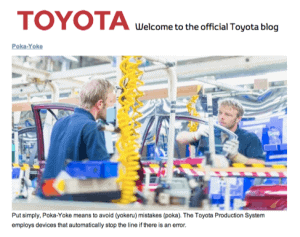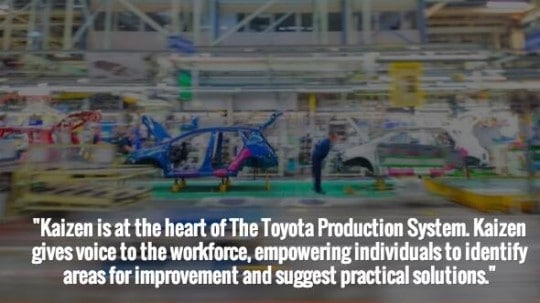
I didn't know , until yesterday, that Toyota has an official company blog (at least for Toyota UK).
Even though I've learned from Toyota people and many books and classes (and I've written books of my own), I always encourage people to get Toyota Production System knowledge directly from the source whenever possible – including the books of Ohno & Shingo and modern-day Toyota people like Pascal Dennis, David Meier, John Shook, and others).
Toyota has a post about 13 “pillars” (principles, really?) of the Toyota Production System. Check it out.
Most of the principles are incredibly helpful in healthcare. We need more of this thinking and more of these practices… not to “turn the hospital into a factory,” but to make the hospital a safer, better place for patients and healthcare providers.
Hansei: Do we even have time in healthcare to talk about our “failures” during the day, to reflect, learn, and improve? Many times, people in healthcare seem to not even want to talk about failures or potential failures.
Andon: Other than organizations like Virginia Mason Medical Center and their “patient safety alert system,” do we have systems in place where nurses and staff can actually put their hand up and say things like:
- “hey, I'm overburdened right now and could use some help” (and actually get help)
- “there's a potential risk for error here” (and actually have people stop to confirm things are OK or fix the problem)
When I take healthcare folks to the Toyota San Antonio plant, they are very impressed by the andon cord system and how a team leader runs (walks, actually) immediately to help investigate the problem (and often helping fix it before the line would have to stop).
Jidoka: Do we have equipment (including software) that stops automatically when there is a problem or a potential problem? We have some of this, but we could use more error proofing in healthcare.
Just in Time: Are we able to provide supplies, medications, and equipment “that they need and only when [they need] them”? Are we able to provide the right care at the right place at the right time for patients? Improving flow and quality go hand in hand.
Heijunka: Are we taking advantage of opportunities to level load workloads or processes where we can (such as hospital lab specimen collections, elective procedure scheduling, etc.) or at least better match staffing to demand in areas where demand is not shapable (like emergency departments)?
Kaizen: Do we have a culture of continuous improvement in healthcare? Not often enough. Are we just doing episodic improvement events or daily continuous improvement? Learn more about this on my Healthcare Kaizen book website and our KaiNexus website.
The Toyota blog says:
Kaizen is at the heart of The Toyota Production System. It serves as a mantra for continuous improvement; the effects of which are far-reaching, from waste elimination to efficiency optimisation. Kaizen gives voice to the workforce, empowering individuals to identify areas for improvement and suggest practical solutions.
Genchi Genbutsu: Do leaders “go and see” at the “gemba” or do they try to solve problems from the office and conference rooms?
Nemawashi: Are decisions made by consensus?
The Toyota blog says:
Decisions shouldn't be dictated by individuals, they should be made as a team – this the thinking behind Nemawashi. In the Toyota Production System, information is shared openly with employees, in order involve them in decision-making processes and allow them to voice their opinions.
Kanban: This is a powerful, yet simple, and effective materials management system that's being used a lot in healthcare. It's a tool, a technical method, that doesn't really challenge or threaten the status quo of the existing management system and culture (but kanban works better when we have the cultural elements described above).
Mura, Muri, and Mura: Lean isn't just about “reducing waste” (or muda). We also have to reduce overburden and unevenness in healthcare work.
Do check out the Toyota post, which includes some great pictures, one of which was the basis for the composite image I made below:

Please scroll down (or click) to post a comment. Connect with me on LinkedIn.
Let’s build a culture of continuous improvement and psychological safety—together. If you're a leader aiming for lasting change (not just more projects), I help organizations:
- Engage people at all levels in sustainable improvement
- Shift from fear of mistakes to learning from them
- Apply Lean thinking in practical, people-centered ways
Interested in coaching or a keynote talk? Let’s talk.
Join me for a Lean Healthcare Accelerator Trip to Japan! Learn More









